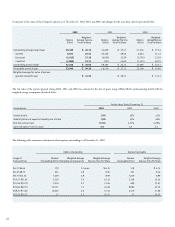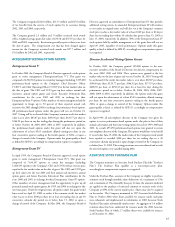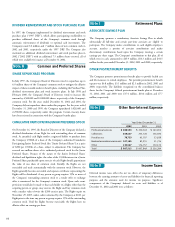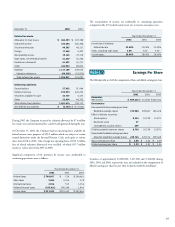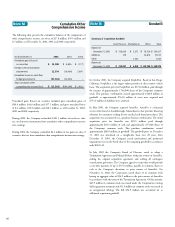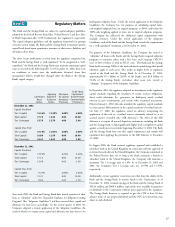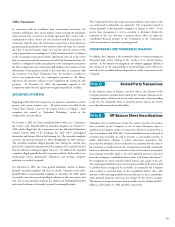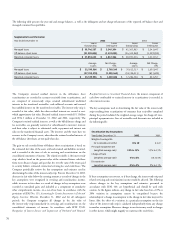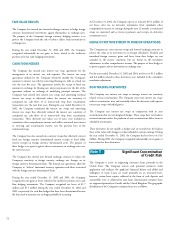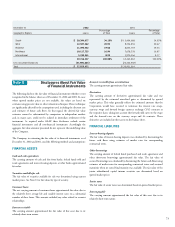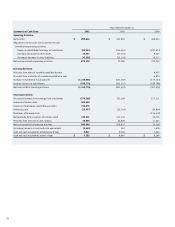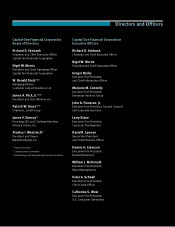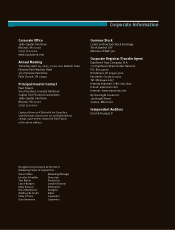Capital One 2002 Annual Report Download - page 74
Download and view the complete annual report
Please find page 74 of the 2002 Capital One annual report below. You can navigate through the pages in the report by either clicking on the pages listed below, or by using the keyword search tool below to find specific information within the annual report.
72
FAIR VALUE HEDGES
The Company has entered into forward exchange contracts to hedge foreign
currency denominated investments against fluctuations in exchange rates.
The purpose of the Company’s foreign currency hedging activities is to
protect the Company from the risk of adverse affects from movements in
exchange rates.
During the year ended December 31, 2002 and 2001, the Company
recognized substantially no net gains or losses related to the ineffective
portions of its fair value hedging instruments.
CASH FLOW HEDGES
The Company has entered into interest rate swap agreements for the
management of its interest rate risk exposure. The interest rate swap
agreements utilized by the Company effectively modify the Company’s
exposure to interest rate risk by converting floating rate debt to a fixed rate
over the next five years. The agreements involve the receipt of fixed rate
amounts in exchange for floating rate interest payments over the life of the
agreement without an exchange of underlying principal amounts. The
Company had entered into interest rate swaps and amortizing notional
interest rate swaps to effectively reduce the interest rate sensitivity of
anticipated net cash flows of its interest-only strip from securitization
transactions over the next four years. During the year ended December 31,
2002, the Company terminated the interest rate swaps and amortizing
interest rate swaps that effectively reduced the interest rate sensitivity of
anticipated net cash flows of its interest-only strip from securitization
transactions. These derivative fair values, net of taxes, were included in
cumulative other comprehensive income and will be amortized into interest
or servicing and securitizations income over the previous lives of the
terminated swaps.
The Company has also entered into currency swaps that effectively convert
fixed rate foreign currency denominated interest receipts to fixed dollar
interest receipts on foreign currency denominated assets. The purpose of
these hedges is to protect against adverse movements in exchange rates over
the next four years.
The Company has entered into forward exchange contracts to reduce the
Company’s sensitivity to foreign currency exchange rate changes on its
foreign currency denominated loans. The forward rate agreements allow the
Company to “lock-in” functional currency equivalent cash flows associated
with the foreign currency denominated loans.
During the year ended December 31, 2002 and 2001, the Company
recognized no net gains or losses related to the ineffective portions of its cash
flow hedging instruments. The Company recognized net losses of $1.7
million and $5.1 million during the year ended December 31, 2002 and
2001, respectively, for cash flow hedges that have been discontinued because
the forecasted transaction was no longer probable of occurring.
At December 31, 2002, the Company expects to reclassify $55.2 million of
net losses, after tax, on derivative instruments from cumulative other
comprehensive income to earnings during the next 12 months as terminated
swaps are amortized and as interest payments and receipts on derivative
instruments occur.
HEDGE OF NET INVESTMENT IN FOREIGN OPERATIONS
The Company uses cross-currency swaps and forward exchange contracts to
protect the value of its investment in its foreign subsidiaries. Realized and
unrealized foreign currency gains and losses from these hedges are not
included in the income statement, but are shown in the translation
adjustments in other comprehensive income. The purpose of these hedges is
to protect against adverse movements in exchange rates.
For the years ended December 31, 2002 and 2001, net losses of $3.2 million
and $.6 million related to these derivatives were included in the cumulative
translation adjustment.
NON-TRADING DERIVATIVES
The Company uses interest rate swaps to manage interest rate sensitivity
related to loan securitizations. The Company enters into interest rate swaps
with its securitization trust and essentially offsets the derivative with separate
interest rate swaps with third parties.
The Company uses interest rate swaps in conjunction with its auto
securitizations that are not designated hedges. These swaps have zero balance
notional amounts unless the paydown of auto securitizations differs from its
scheduled amortization.
These derivatives do not qualify as hedges and are recorded on the balance
sheet at fair value with changes in value included in current earnings. During
the year ended December 31, 2002, the Company had net losses of $1.6
million. During 2001, the Company recognized substantially no net gains or
losses related to these derivatives.
Note T Significant Concentration
of Credit Risk
The Company is active in originating consumer loans, primarily in the
United States. The Company reviews each potential customer’s credit
application and evaluates the applicant’s financial history and ability and
willingness to repay. Loans are made primarily on an unsecured basis;
however, certain loans require collateral in the form of cash deposits and
automobiles serve as collateral for auto loans. International consumer loans
are originated primarily in Canada and the United Kingdom. The geographic
distribution of the Company’s consumer loans was as follows:


